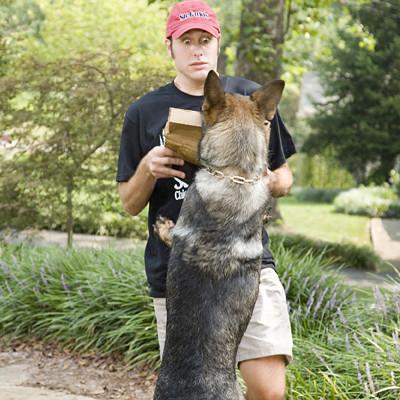By Toni Gibson-Mark
Just like people, pets are afraid of certain things. Vacuum cleaners, swimming, veterinary offices, and more—it’s easy to see that there are certain things that dogs are afraid of. Unfortunately, some of these things are necessary in our lives, which means there is a good possibility that your dog might encounter their worst fears. That means discussing our pet’s fear is a most worthy discussion! Why are dogs afraid of things? 
There are many reasons why dogs can be afraid of things. One of the most common reasons is because they have built a negative association with that thing. For example, dogs that have had their nails clipped too short can quickly become afraid of having their nails cut again or have their feet handled. They are afraid because they associated nail clippings with a painful experience.
Another common reason why pets can be afraid of things is because they were not introduced to it when they were puppies. Puppies start to learn about their reality in the first 16 weeks of their lives. It is very important to keep them with their littermates until they’re at least 8 weeks old so that they can learn to relate with other dogs. Also, in the first 3 months of their lives, they should be introduced to as many things as possible to reduce the chance that they’ll be afraid of them later in life. 
If puppies aren’t introduced to things when they are young, there is a chance they can become fearful of them later. For example, if puppies were never introduced to men wearing hats, they might become fearful of them later in life. This goes the same way for vacuum cleaners. If puppies were not socialized to a vacuum cleaner, it might become a source of fear for them. All of this means we have some control over what our dogs are afraid of.
As puppies grow, they should be properly introduced and socialized to as many things as possible. Additionally, when we introduce all age dogs to new things, it’s important to make sure that the dog has a positive experience with that new thing.
Provide your dog with treats or praise when introducing new things, such as umbrellas, vacuums, and new people. You should also consider introducing things slowly so that the experience isn’t overwhelming.
For example, when introducing a dog to the vacuum, introduce them to the vacuum itself and make that a positive experience before turning it on. Slowly get your dog more acclimated to the vacuum and eventually turn it on.
What this also means is that we sometimes don’t get to choose what our dogs are afraid of. Especially for shelter dogs, we might not have the opportunity to introduce the dogs to things when they are young. Additionally, they might come to you with things they are already afraid of due to past experiences. In this case, the best thing you can do is try to rebuild a positive association with that thing.
For example, if your dog is afraid of swimming, you will want to break down swimming in small parts and reward your dog for accomplishing each of them. When your dog is 10 feet away from a pool, reward your dog with treats and praise until they are comfortable. Move closer and do the same thing. When you are nearby the pool, have your dog put one foot in the water and reward and praise them until they are comfortable with that. Slowly introduce more aspects of swimming until your dog gets all the way in the pool.
Although our dog’s fears sometimes don’t seem rational to us (I mean—what’s so scary about a vacuum anyway??), it doesn’t mean they don’t truly fear it. There are many people that think it’s silly for us to be afraid of spiders, snakes, clowns, etc. But that doesn’t mean we don’t feel REAL fear when we come in contact with those things. Be empathetic to your dog’s fears and consider how you would feel if youwere that afraid. Develop a training plan to make your dog feel comfortable in those situations.


